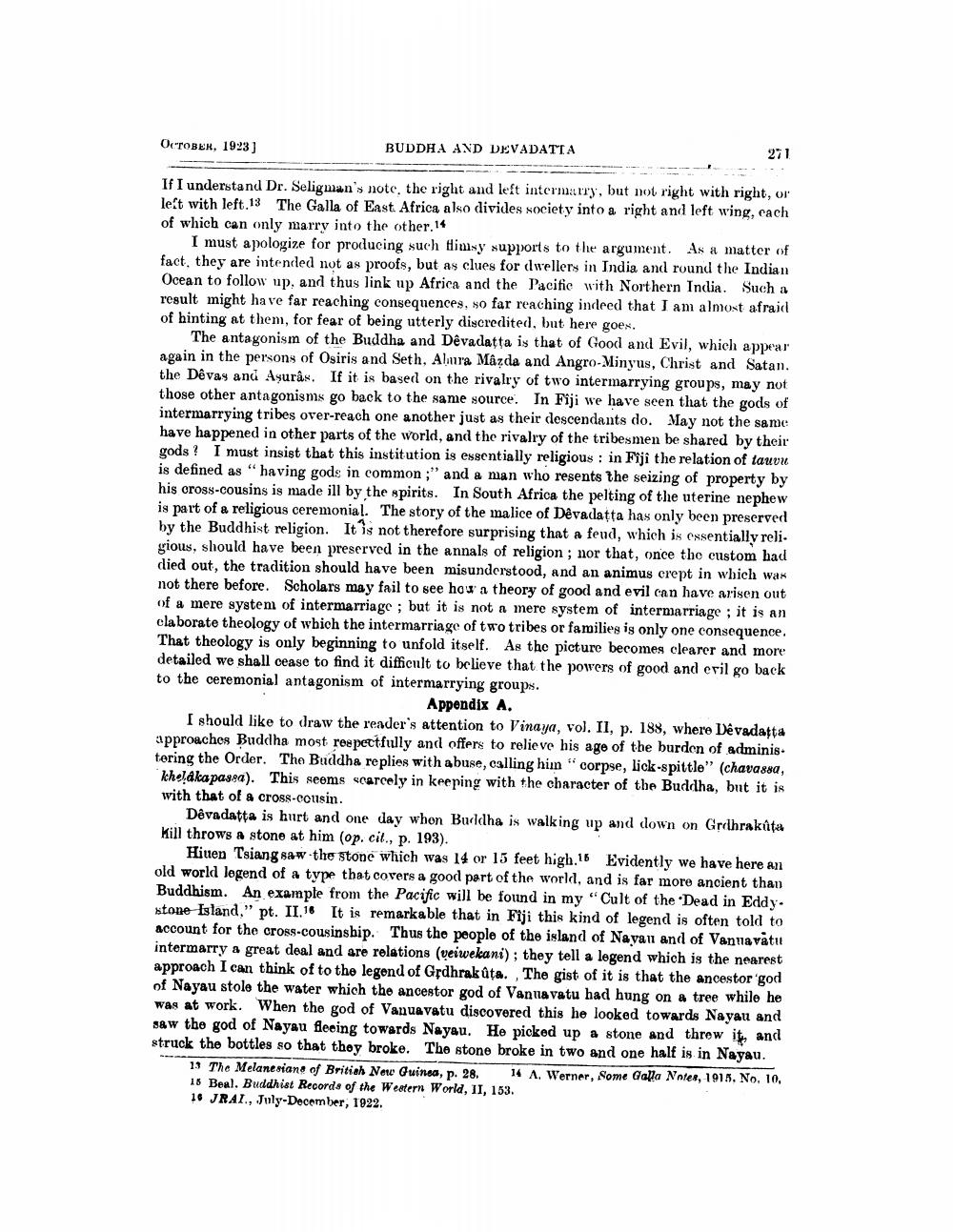________________
OCTOBER, 1923)
BUDDHA AND DEVADATTA
271
If I understand Dr. Seligman's note, the right and left intermarry, but not right with right, or left with left.13 The Galla of East Africa also divides society into a right and left wing, cach of which can only marry into the other. 14
I must apologize for producing such flimsy supports to the argument. As a matter of fact, they are intended not as proofs, but as clues for dwellers in India and round the Indian Ocean to follow up, and thus link up Africa and the Pacific with Northern India. Such a result might have far reaching consequences, so far reaching indeed that I am almost afraid of hinting at them, for fear of being utterly discredited, but here goes.
The antagonism of the Buddha and Dêvadatta is that of Good and Evil, which appear again in the persons of Osiris and Seth, Aluva Mazda and Angro-Minyus, Christ and Satan. the Devas and Ayurâs. If it is based on the rivalry of two intermarrying groups, may not those other antagonisms go back to the same source. In Fiji we have seen that the gods of intermarrying tribes over-reach one another just as their descendants do. May not the same have happened in other parts of the world, and the rivalry of the tribesmen be shared by their gods? I must insist that this institution is essentially religious : in Fiji the relation of tauvu is defined as "having gods in common;" and a man who resents the seizing of property by his cross-cousins is made ill by the spirits. In South Africa the pelting of the uterine nephew is part of a religious ceremonial. The story of the malice of Dêvadatta has only been preserved by the Buddhist religion. It is not therefore surprising that a feud, which is essentially reli. gious, should have been preserved in the annals of religion ; nor that, once the custom had died out, the tradition should have been misunderstood, and an animus erept in which was not there before. Scholars may fail to see how a theory of good and evil can have arisen out of a mere system of intermarriage ; but it is not a mere system of intermarriage ; it is an elaborate theology of which the intermarriage of two tribes or families is only one consequence. That theology is only beginning to unfold itself. As the picture becomes clearer and more detailed we shall cease to find it difficult to believe that the powers of good and evil go back to the ceremonial antagonism of intermarrying groups.
Appendix A. I should like to draw the reader's attention to Vinaya, vol. II, p. 188, where Dévadatta approaches Buddha most respectfully and offers to relieve his age of the burden of adminis. tering the Order. The Buddha replies with abuse, calling himn corpse, lick-spittle" (chava88a, khelaka pasea). This seems scarcely in keeping with the character of the Buddha, but it is with that of a cross-cousin.
Dévadatta is hurt and one day whon Buldha is walking up and down on Grethrakuta Kill throws a stone at him (op. cit., p. 193).
Hiuen Tsiang saw the stone which was 14 or 15 feet high.16 Evidently we have here an old world legend of a type that covers a good part of the world, and is far more ancient than Buddhism. An example from the Pacific will be found in my "Cult of the Dead in Eddy. stone Island," pt. II.16 It is remarkable that in Fiji this kind of legend is often told to account for the cross-cousinship. Thus the people of the island of Nayani and of Vannavati intermarry a great deal and are relations (veiwekani); they tell a legend which is the nearest approach I can think of to the legend of Grdhrakūta. The gist of it is that the ancestor god of Nayau stole the water which the ancestor god of Vanuavatu had hung on a tree while he was at work. When the god of Vanuavatu discovered this he looked towards Nayau and saw the god of Nayau fleeing towards Nayau. He picked up a stone and threw it and struck the bottles so that they broke. The stone broke in two and one half is in Nayau.
13 The Melanesian of British Now Guinea, p. 28. 14 A. Werner, Some Galla Nnter, 1915. No. 10, 18 Beal. Buddhist Records of the Western World, II, 153. 19 JRAI, July-December, 1922.




